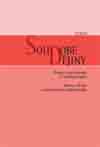Příliš nebezpečná Morava? Moravský patriotismus v poválečném Československu (1945–1989)
Moravia, Too Dangerous? Moravian Patriotism in Post-war Czechoslovakia, 1945–89
Author(s): Jiří PernesSubject(s): History
Published by: AV ČR - Akademie věd České republiky - Ústav pro soudobé dějiny
Summary/Abstract: This article examines the phenomenon of ‘Moravianness’ (Moravian patriotism) and its development in interaction with Czechoslovak politics and social change from the end of the Second World War to the collapse of the Communist régime. Moravianness is rooted deep in history and it has been expressed in different, sometimes striking ways at various times. In the nineteenth century, according to the author, most Slav inhabitants of Moravia considered themselves Moravian rather than Czech. During the First World War Czech national consciousness predominated amongst them, and then intensifi ed in the new state of Czechoslovakia, when the provincial government and the cultural and political institutions expressing the special character of Moravia were retained in Moravia. The republic was restored in this form after the Second World War, with the Moravian-Silesian National Committee (Zemský národní výbor) in Brno and a branch office in Ostrava and adhering to the provincial arrangement of running of economic life in Moravia. Moravian institutions, including the Moravian-Silesian organizations of the democratic political parties and the National Assembly deputies from Moravia and Silesia had to wrestle with growing Prague (or Czech) centralism. The Czechoslovak People’s Party advocated the clearest existence of the historical lands, but the Czechoslovak Communist Party, which, after victory in the general elections of spring 1946, controlled the Moravian National Committee in Brno, came out against that. After the Communists established a monopoly of power, they substituted regional government (krajské zřízení) for provincial (zemské), taking effect as of 1949 and in some cases not respecting the borders of the historical lands. In their centralist policy there was no room for special Moravian needs, yet they expediently used Moravian tradition, particularly the folklore of Moravian Slovakia (Slovácko), which helped to enhance the government’s image as being of the ‘common people’, and also gave support to Moravian archaeology, which could provide evidence of the ancient historical roots of the Czech state. But that also had unwanted consequences by gradually reviving Moravian self-confidence in the 1960s. Here the author emphasizes the unusual response to the ‘The Great Moravia’ exhibition in 1963, and recalls the ‘hockey affair’ two years later, when a trivial statement printed in a newspaper after a match of the Kometa Brno hockey team provoked n avalanche of outraged letters from Moravian readers complaining about alleged Czech chauvinism. Moravianness enjoyed a renascence during the Prague Spring of 1968. Numerous eminent Moravians and Moravian institutions called for the restoration of the provincial government and the Society for Moravia and Silesia was established with this aim. Their hopes were dashed by the federalization of Czechoslovakia and the policy of ‘normalization’ after the Soviet-led military intervention of August 1968.
Journal: Soudobé Dějiny
- Issue Year: XVII/2010
- Issue No: 03
- Page Range: 392-420
- Page Count: 29
- Language: Czech

